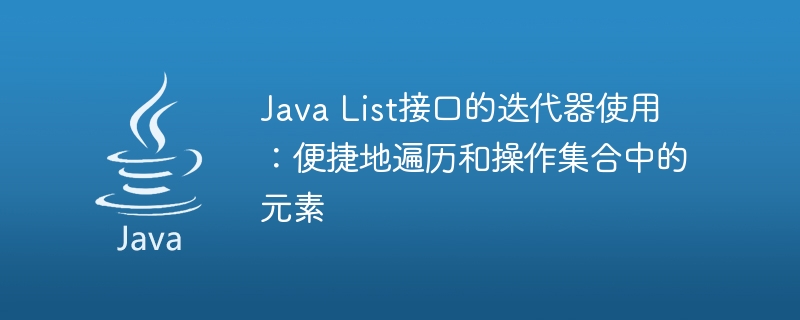

The List interface in Java provides an ordered collection that allows the storage of repeated elements. In actual development, we often need to traverse the elements in the List and operate on them, and Java's List interface provides a variety of methods to achieve this purpose. This article will introduce how to use the iterator of the List interface to conveniently traverse and operate elements in the collection.
In Java, the List interface inherits from the Collection interface. The elements in the List are stored in a specific order and allow access to elements using indexes. The List interface provides a wealth of methods to operate elements in the collection, such as adding, deleting, and obtaining elements. When traversing a List, iterators are usually used. Iterators provide a convenient and safe way to access elements in the collection.
First, let’s take a look at how to get the iterator of List. The List interface provides the iterator() method, which returns a ListIterator object. ListIterator is a sub-interface of the Iterator interface and provides more methods to operate elements in the List. Through ListIterator, we can perform two-way traversal in the collection and modify the elements in the collection through the iterator. The following is an example of getting a List iterator and traversing the List:
List<String> list = new ArrayList<>();
list.add("Java");
list.add("Python");
list.add("C++");
// 获取List迭代器
ListIterator<String> iterator = list.listIterator();
// 正向遍历List
while(iterator.hasNext()) {
String element = iterator.next();
System.out.println(element);
}
// 反向遍历List
while(iterator.hasPrevious()) {
String element = iterator.previous();
System.out.println(element);
}In the above example, we first created an ArrayList and added several elements to it. Then the ListIterator object is obtained by calling the listIterator() method of the list, then using the while loop and next() method for forward traversal, and the hasPrevious() and previous() methods for reverse traversal. In this way we can easily traverse the elements in the List.
In addition to using ListIterator, we can also use forEach loop to traverse the elements in the List. The forEach() method is provided in the List interface, which can accept a Consumer functional interface as a parameter and operate on the elements in the collection by passing in a Lambda expression. Here is an example of using a forEach loop to traverse a List:
List<String> list = new ArrayList<>();
list.add("Java");
list.add("Python");
list.add("C++");
// 使用forEach遍历List
list.forEach(element -> System.out.println(element));In the above example, we created an ArrayList and added several elements to it. Then we called the forEach() method of List, passing in a Lambda expression to iterate over the elements in the collection and print them out. This method is concise and clear, and is especially suitable for simple operations on elements in the collection.
In addition, in addition to using iterators and forEach loops, we can also use ordinary for loops to traverse the elements in the List. By getting the size of the List and using the get method to get the elements, you can traverse and operate the collection. The following is an example of using a normal for loop to traverse a List:
List<String> list = new ArrayList<>();
list.add("Java");
list.add("Python");
list.add("C++");
// 使用普通for循环遍历List
for(int i=0; i<list.size(); i++) {
String element = list.get(i);
System.out.println(element);
}In the above example, we created an ArrayList and added several elements to it. Then we use the loop variable i and the get method to obtain the elements in the List one by one and perform operations. Although this method is relatively basic, it is also very commonly used in certain situations.
Through the above introduction, we can see that Java's List interface provides a variety of convenient methods to traverse and operate elements in the collection. Whether you use ListIterator, forEach loop or ordinary for loop, you can traverse and operate the elements in the List. In actual development, we can choose the appropriate traversal method according to specific needs to achieve efficient operations on the elements in the collection. I hope this article will be helpful to everyone when using Java List.
The above is the detailed content of Iterators using the Java List interface: Easily traverse and manipulate elements in a collection. For more information, please follow other related articles on the PHP Chinese website!
